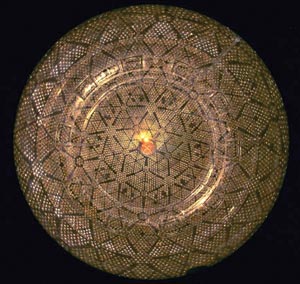
The Sun shines, just as described by our best theories of its thermonuclear furnace. Neutrinos oscillate – at least, electron-neutrinos change into another type. These are the main conclusions of the neutral-current (NC) results from the Sudbury Neutrino Observatory (SNO) in the Creighton Mine, Ontario, Canada.
In 1985, Herb Chen from the University of California, Irvine, first pointed out that heavy water offered a direct approach to solving the “solar neutrino problem” – the deficiency between the number of solar neutrinos detected on Earth and the flux predicted by the standard solar models. The discrepancy raised the possibility that the electron-neutrinos emitted by the Sun changed to another type (muon or tau) somewhere between emission and detection. Chen realized that an experiment was needed to detect all neutrino types equally, and that the way to do this was through NC interactions between neutrinos and nuclei. (Elastic scattering, or ES, between neutrinos and electrons is possible but more complicated because there are contributions from both NC and charged-current, or CC, reactions for electron-neutrinos, but not for the other species.) He proposed that heavy water would be the ideal detection medium. The NC reaction, due to all neutrinos, simply splits the deuterium nucleus into a proton and a neutron, while a CC reaction, due only to electron-neutrinos, changes the neutron into a proton accompanied by an electron. In both cases, the heavy water acts as both target and detector. The neutrons released in the NC reaction can be detected through the 6.25 MeV gamma ray released when they are captured by deuterium. The gamma rays and the electrons produced in the CC reaction are observed through the Cerenkov radiation they create in the water.
Chen’s proposal led directly to the construction of the SNO, based on 1000 tonnes of heavy water, although sadly Chen himself did not live to see the detector he had envisioned. Last year the SNO collaboration published the first results from the CC and ES reactions. When combined with data from other detectors, these results provided strong evidence that neutrinos change type, or oscillate. Chen’s dream has now been realized, and the first results from the NC interactions of solar neutrinos in heavy water have been announced. SNO has unambiguous evidence for neutrino oscillation in data from a single detector.
To detect the NC reactions, the SNO team looks for the Cerenkov light from the gamma rays from neutron capture. There are many background signals, in particular from daughter products of the natural uranium and thorium decay chains, which produce free neutrons through photodisintegration of deuterium. As Chen realized, the very nucleus that makes the detector effective is also the cause of its biggest background problem. The vessel containing the heavy water is therefore surrounded by 7000 tonnes of light water, to absorb gamma rays and neutrons from radioactivity in the surrounding rock. In addition, the SNO collaboration has developed a water purification system that reduces concentrations of elements from the uranium and thorium decay chains to a million times lower than those in natural water, which means impurity levels less than 10-14 g/g for the heavy water and less than 10-13 g/g for the light water.
So far the team has applied detailed analysis to data taken between November 1999 and May 2001. They use NC reactions to measure the total flux of solar boron-8 neutrinos (to which SNO is sensitive), which they find to be 5.09 + 0.44 – 0.43 (statistical) + 0.46 – 0.43 (systematic) ¥ 106 cm-2s-1. This is completely consistent with standard solar models – there are no missing solar neutrinos. The measurements for the CC and ES reactions, in contrast, lead to the fluxes of electron-neutrinos and neutrinos of other types from the boron-8 decays in the Sun. The electron-neutrino component of the flux is found to be 1.76 + 0.05 – 0.05 + 0.09 – 0.09 ¥ 106 cm-2s-1, while the non-electron-neutrino component is about twice as large, at 3.41 + 0.45 – 0.45 + 0.48 – 0.45 ¥ 106 cm-2s-1, or 5.3 standard deviations above zero. This is compelling evidence that about two-thirds of the electron-neutrinos from the Sun do indeed change to another type or “flavour” before they are detected.
The challenge now is to discover more about the precise mechanism that mixes the different neutrino flavours and makes them oscillate from one type to another. SNO has already begun this further exploration through a first measurement of day and night energy spectra for solar neutrinos. Travel through the Earth might alter the spectrum according to certain theories of neutrino mixing, through enhancement by matter. The SNO finds a night-day asymmetry for electron-neutrinos of 7.0% ± 4.9% + 1.3% – 1.2%. A global fit to these SNO data and those from other experiments, in terms of oscillations between two flavours, limits possible theories by strongly favouring a solution with large mixing angles. The “missing” solar neutrinos may no longer be missing, but they are providing a means to learn more about the particles themselves.
<textbreak=Reference>Q R Ahmad et al. nucl-ex/0204008 and nucl-ex/0204009 at http://www.arxiv.org/.





